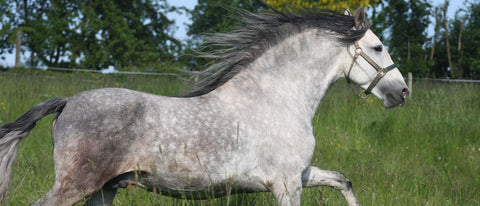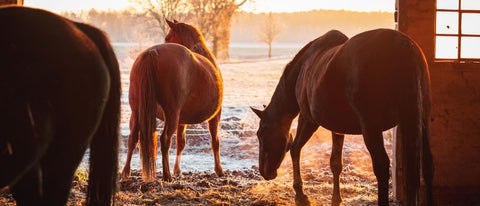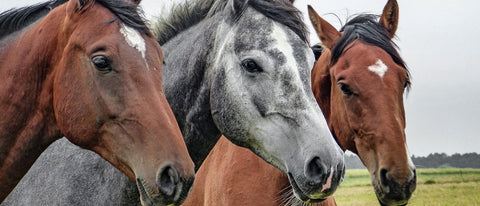
Florian ist aufgewachsen auf einem Bauernhof. Umgeben von Pferden, entdeckte er früh seine Faszination für diese majestätischen Tiere. Inspiriert von seiner reitbegeisterten Mutter, entwickelte er das Nahrungsergänzungmittel - Pferdegold. Seine tiefe Verbundenheit zur Natur und die leidenschaftliche Hingabe zu Pferden trieben ihn an, sein Unternehmen zu gründen.
A well-structured training plan promotes your horse's physical fitness and well-being. Individual training programs tailored to discipline and needs lead to sustainable success. Supplemental feed supports muscle building with high-quality proteins and essential amino acids.
Why a training plan is important for horses
An individual and well -thought-out training plan is essential to promote your horse's willingness to perform and general well-being .
- It not only increases physical fitness,
- but also supports rehabilitation after training breaks.
Through regular training and targeted exercise phases, the horse remains flexible and powerful .
Advantages of a structured training plan
Increased endurance: improved performance on long rides.
Muscle building : Targeted strengthening of the muscles for more stability.
Regeneration: Faster recovery after training breaks.
Individual adaptation: Training content that meets the specific needs of each horse.
Creating an effective training plan for horses
First, it is important to analyze your horse's current fitness level . Make a list of the individual goals you want to achieve – be it
- Improve endurance,
- muscle building
- or rehabilitation.
Realistic milestones are crucial to making progress measurable.
Steps to create the training plan:
-
Analysis of the current condition: Determine the current condition and any health issues.
-
Goal definition: Set clear and measurable goals, whether short-term or long-term.
-
Planning the units: Determine which exercises and stress phases are necessary.
-
Plan for regeneration: Make sure you take enough breaks to avoid overloading.
- Continuous adaptation: Adjust the plan regularly as your training progresses.
A checklist can be very helpful here:
- Determine current status
- Define personal training goals
- Plan daily and weekly stress phases
- Set regeneration times
- Carry out success check
Does it make sense to ride the horse every day?
Horses need exercise – but not only in the saddle. Variety is key: A mix of
- Ride,
- Ground work
- and relaxed rides keep her physically fit and mentally balanced.
Those who pay attention to their horse's needs not only strengthen their well-being but also their bond.
Specific training aspects for different disciplines
Each equestrian discipline has its own requirements , which should be reflected in the training plan . For dressage horses, technical precision and balance play a key role, while in show jumping, speed and skill are paramount.
Eventing horses also require a varied program that combines technical, strength and endurance components.
Advantages of discipline-specific training plans:
- Discipline: Essential training aspects
- Dressage: Looseness, suppleness, collection, balance
- Jumping: rhythm, canter control, jumping technique
- Versatility: Condition, stamina, obedience, agility
- Western riding: Responsiveness to subtle aids, calm and controlled maneuvers, composure, nerve strength
- Gaited horse riding: gait development, balance, carrying capacity, individual gait correction
- Polo: Speed, agility, confidence, nerves of steel, one-handed rideability
Training plan for young horses
With young horses , such as 3- to 5-year-olds , it is especially important to gently acclimate the body to the training load . A structured training plan helps promote natural development and avoid later performance deficits.
Tips for working with young horses:
- Start with short, varied units
- Make sure you have sufficient recovery periods
- Integrate playful elements to maintain motivation
Training plan for overweight horses
Overweight can significantly reduce your horse’s performance
A special training plan for overweight horses combines targeted exercise sessions with adapted feeding.
The main focus is on
- rides,
- Lunging
- and groundwork exercises are in the foreground to boost the metabolism.
Special recommendations:
- Moderate exercise: Start with shorter sessions and gradually increase the duration.
- Radial Mix: Combine rides with lunging to challenge the muscles holistically.
- Nutrition: Make sure the food is balanced.
Muscle building in horses: what you should consider
Muscle development in horses is essentially based on two factors:
- targeted training
- and a balanced diet.
Proteins are the building blocks of muscles and play a key role in the development and regeneration of muscle tissue. To enable your horse to develop its full muscle strength, it is crucial to provide it with protein-rich and nutrient-optimized feed .
This is where Pferdegold® Muscles comes into play: The specially developed supplementary feed supports targeted muscle building through a balanced recipe with
- 50% spirulina algae
- as well as important amino acids such as methionine, lysine, threonine and carnitine.
This ensures that your horse is optimally nourished during active training, during the growth phase, and even in old age. With its hand-selected ingredients and drug-free formulation, Pferdegold® Muscles sets new standards in horse nutrition and fitness.

Pferdegold® Muscles
The product Pferdegold Muscles supports muscle building in your horse. A lack of nutrients is a major cause of poor endurance and low performance. To protect your horse from this and to increase endurance and performance, the muscles must be supplied with important nutrients.
Order nowWhy choose Pferdegold® Muscles?
- High-quality plant proteins specifically promote muscle building
- Contains essential amino acids for growth and regeneration
- Ideal for sport horses, young horses and seniors
Conclusion
A structured training plan or exercise plan in combination with an optimized diet is the key to a high-performance horse.
With targeted training sessions and high-quality supplementary feed such as Pferdegold® Muscles, you can sustainably promote your horse's muscle development and improve its overall fitness.
Experience how your four-legged friend becomes a vital and competitive athlete with a tailor-made training plan, regular exercise, and the right nutrition.
FAQ
How often should a horse be trained per week?
A well-conditioned horse benefits from about five training sessions per week, with at least one rest day always planned¹.
How can I tell if my horse is overweight?
The Body Condition Score (BCS) is a proven tool for assessing your horse's weight and fat distribution.
How long should a training session last?
A training session should last between 30 and 60 minutes – adapted to the horse’s fitness level and individual needs.
What should I do if my horse is not making any visible progress in building muscle?
Review the horse's feeding, training schedule, and any external factors such as saddle fit. A veterinarian or nutritionist can provide helpful recommendations.
Can training be effective without riding?
Yes, alternative exercises such as ground work, lunging and walking are effective methods to strengthen muscles.
Important:
Pferdegold is not a substitute for veterinary diagnosis or treatment. The information contained in this article is for general informational purposes only and is intended to help improve your horse's well-being.
Pferdegold products do not treat or cure diseases, but rather support your horse in compensating for nutritional deficiencies through targeted nutrient intake.
However, they are not a substitute for professional advice from a veterinarian or specialist. If your horse has any health problems, we strongly recommend consulting a veterinarian. Pferdegold assumes no liability for decisions made based on the information provided here.
🐎 You want to read more about the intestines and health of horses:

















